INSTITUT SUPERIEUR D'ANTHROPOLOGIE
INSTITUTE OF ANTHROPOLOGY
ONLINE COURSES / COURS A DISTANCE
INSCRIPTION 2012 / Session III : Juillet 2012
REGISTRATION 2012 / Term III : July 2012
FRANCE – 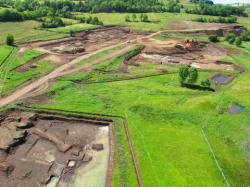 Le Puy en Velay - De mai à octobre, les archéologues de la société Archeodunum, opérateur d'archéologie agréé par le Ministère de la Culture et de la Communication, en association avec les terrassiers de La Forézienne, travaillent pour mettre au jour les vestiges archéologiques enfouis dans le sol de la commune du Puy-en-Velay, au lieu-dit Les Reliades. Depuis deux mois, les pelles mécaniques s’activent pour ouvrir la terre et révéler les témoins d’une fréquentation dont l’origine remonte au moins à l’âge du Fer (800 – 30 avant notre ère). L’histoire de ces recherches commence dès l’automne 2010. Afin d’éviter toute découverte fortuite qui pénaliserait le déroulement des travaux du contournement de l'agglomération du Puy-en-Velay par la RN 88, les archéologues de l’Institut National de Recherche Archéologique Préventive (Inrap) sont intervenus pour diagnostiquer la présence de vestiges archéologiques. En creusant des tranchées de sondage, ils ont ainsi pu mettre en évidence, au lieu-dit Les Reliades, un secteur sur lequel les témoins d’occupations humaines successives se sont avérés les plus importants : vestiges d’habitations gauloises, restes de bâtiments d’époque romaine, témoins d’aménagements agricoles... Au terme de cette opération, un rapport a été remis au Service Régional d’Archéologie (DRAC). Ce dernier soulignant l’intérêt historique de ce secteur, a demandé à ce qu’une fouille soit réalisée, afin de sauvegarder "par l’étude" les vestiges menacés par la construction du contournement.
Le Puy en Velay - De mai à octobre, les archéologues de la société Archeodunum, opérateur d'archéologie agréé par le Ministère de la Culture et de la Communication, en association avec les terrassiers de La Forézienne, travaillent pour mettre au jour les vestiges archéologiques enfouis dans le sol de la commune du Puy-en-Velay, au lieu-dit Les Reliades. Depuis deux mois, les pelles mécaniques s’activent pour ouvrir la terre et révéler les témoins d’une fréquentation dont l’origine remonte au moins à l’âge du Fer (800 – 30 avant notre ère). L’histoire de ces recherches commence dès l’automne 2010. Afin d’éviter toute découverte fortuite qui pénaliserait le déroulement des travaux du contournement de l'agglomération du Puy-en-Velay par la RN 88, les archéologues de l’Institut National de Recherche Archéologique Préventive (Inrap) sont intervenus pour diagnostiquer la présence de vestiges archéologiques. En creusant des tranchées de sondage, ils ont ainsi pu mettre en évidence, au lieu-dit Les Reliades, un secteur sur lequel les témoins d’occupations humaines successives se sont avérés les plus importants : vestiges d’habitations gauloises, restes de bâtiments d’époque romaine, témoins d’aménagements agricoles... Au terme de cette opération, un rapport a été remis au Service Régional d’Archéologie (DRAC). Ce dernier soulignant l’intérêt historique de ce secteur, a demandé à ce qu’une fouille soit réalisée, afin de sauvegarder "par l’étude" les vestiges menacés par la construction du contournement.
http://www.leveil.fr/actualite/Le-Puy-en-Velay-des-vestiges-gaulois-et-romains-mis-au-jour-sur-le-chantier-du-contournement-101143
ROYAUME UNI – 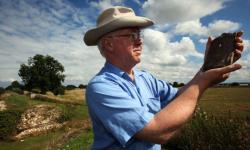 Silvester - Iron Age Britons were importing olives from the Mediterranean a century before the Romans arrived with their exotic tastes in food, say archaeologists who have discovered a single olive stone from an excavation of an Iron Age well at at Silchester in Hampshire. The stone came from a layer securely dated to the first century BC, making it the earliest ever found in Britain – but since nobody ever went to the trouble of importing one olive, there must be more, rotted beyond recognition or still buried. The stone, combined with earlier finds of seasoning herbs such as coriander, dill and celery, all previously believed to have arrived with the Romans, suggests a diet at Silchester that would be familiar in any high street pizza restaurant. The excavators, led by Professor Mike Fulford of Reading University, also found another more poignant luxury import: the skeleton of a tiny dog, no bigger than a modern toy poodle, carefully buried, curled up as if in sleep. However it may not have met a peaceful end. Fulford has been leading the annual summer excavations at Silchester It was an important Roman town, but deliberately abandoned in the 7th century, its wells blocked up and its buildings tumbled, and never reoccupied. Apart from a few Victorian farm buildings, it is still open farmland, surrounded by the jagged remains of massive Roman walls. Fulford now believes that the town was at its height a century before the Roman invasion in 43AD, with regularly planned, paved streets, drainage, shops, houses and workshops, trading across the continent for luxury imports of food, household goods and jewellery, enjoying a lifestyle in Britain that, previously, was believed to have arrived with the Romans.
Silvester - Iron Age Britons were importing olives from the Mediterranean a century before the Romans arrived with their exotic tastes in food, say archaeologists who have discovered a single olive stone from an excavation of an Iron Age well at at Silchester in Hampshire. The stone came from a layer securely dated to the first century BC, making it the earliest ever found in Britain – but since nobody ever went to the trouble of importing one olive, there must be more, rotted beyond recognition or still buried. The stone, combined with earlier finds of seasoning herbs such as coriander, dill and celery, all previously believed to have arrived with the Romans, suggests a diet at Silchester that would be familiar in any high street pizza restaurant. The excavators, led by Professor Mike Fulford of Reading University, also found another more poignant luxury import: the skeleton of a tiny dog, no bigger than a modern toy poodle, carefully buried, curled up as if in sleep. However it may not have met a peaceful end. Fulford has been leading the annual summer excavations at Silchester It was an important Roman town, but deliberately abandoned in the 7th century, its wells blocked up and its buildings tumbled, and never reoccupied. Apart from a few Victorian farm buildings, it is still open farmland, surrounded by the jagged remains of massive Roman walls. Fulford now believes that the town was at its height a century before the Roman invasion in 43AD, with regularly planned, paved streets, drainage, shops, houses and workshops, trading across the continent for luxury imports of food, household goods and jewellery, enjoying a lifestyle in Britain that, previously, was believed to have arrived with the Romans.
http://www.guardian.co.uk/uk/2012/jul/19/olive-stone-pre-roman-britain?newsfeed=true
USA – 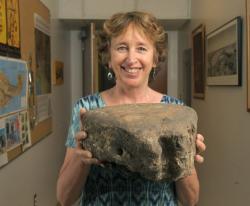 Santa Barbara - The past and future recently collided in the dirt five feet beneath Santa Barbara’s Veterans Memorial Building on Cabrillo Boulevard, where the jaw bone and finger of a Chumash Indian were discovered as well as a host of other Chumash artifacts estimated to be “hundreds and hundreds of years old.” That area along the waterfront was once the site of Syuxtun, a major Chumash community for about 1,000 years with about 500 people in its prime, so UCSB archeologist and anthropology professor Lynn Gamble was hired to ensure no significant historical remains would be disturbed. Gamble, overseeing a team of UCSB students, dug three holes about five feet deep. The UCSB crew dug up 397 shell and glass beads, nine arrow tips, 27 fish hooks, a few bead drills, many stone tools, a bone hairpiece, and the bones of countless fish, sea mammals, and even a giant whale vertebra that Gamble suggested might have been used as a stool. Gamble said the report has yet to be written because much work and analysis still needs to be done. She said she was struck by the richness of material uncovered from so small an area, but given that the village of Syuxtun probably functioned as the Chumash capital for a coastal stretch ranging from Santa Barbara to Pt. Concepcion, it was not that surprising. Archeologists in 1927 reported finding the remains of 300 bodies nearby, and in 1969, the remnants of a large house or sweat lodge was unearthed. Gamble said some of the materials used to make the shell beads and arrowheads came from long distances away, reflecting the extensive trading and sophisticated economic activity undertaken by the Chumash. The Chumash traded for glass beads, she said, from the Spanish colonists, as well as the needles they used to drill the beads. That the Chumash used the Spaniards’ needles to drill their own shell beads, she said, reflected their desire to maintain their own economies. She said she was struck by the abundance of sea mammal bones, which made her wonder if the area served as a butcher’s site. The Chumash skill at harvesting the sea, she said, enabled them to achieve population densities uncharacteristic of hunter-gatherer societies but common for agrarian cultures. The vets building discovery, she suggested, could expand contemporary understanding of just how sophisticated the Chumash trade economy — with both the Spaniards and other tribes — really was.
Santa Barbara - The past and future recently collided in the dirt five feet beneath Santa Barbara’s Veterans Memorial Building on Cabrillo Boulevard, where the jaw bone and finger of a Chumash Indian were discovered as well as a host of other Chumash artifacts estimated to be “hundreds and hundreds of years old.” That area along the waterfront was once the site of Syuxtun, a major Chumash community for about 1,000 years with about 500 people in its prime, so UCSB archeologist and anthropology professor Lynn Gamble was hired to ensure no significant historical remains would be disturbed. Gamble, overseeing a team of UCSB students, dug three holes about five feet deep. The UCSB crew dug up 397 shell and glass beads, nine arrow tips, 27 fish hooks, a few bead drills, many stone tools, a bone hairpiece, and the bones of countless fish, sea mammals, and even a giant whale vertebra that Gamble suggested might have been used as a stool. Gamble said the report has yet to be written because much work and analysis still needs to be done. She said she was struck by the richness of material uncovered from so small an area, but given that the village of Syuxtun probably functioned as the Chumash capital for a coastal stretch ranging from Santa Barbara to Pt. Concepcion, it was not that surprising. Archeologists in 1927 reported finding the remains of 300 bodies nearby, and in 1969, the remnants of a large house or sweat lodge was unearthed. Gamble said some of the materials used to make the shell beads and arrowheads came from long distances away, reflecting the extensive trading and sophisticated economic activity undertaken by the Chumash. The Chumash traded for glass beads, she said, from the Spanish colonists, as well as the needles they used to drill the beads. That the Chumash used the Spaniards’ needles to drill their own shell beads, she said, reflected their desire to maintain their own economies. She said she was struck by the abundance of sea mammal bones, which made her wonder if the area served as a butcher’s site. The Chumash skill at harvesting the sea, she said, enabled them to achieve population densities uncharacteristic of hunter-gatherer societies but common for agrarian cultures. The vets building discovery, she suggested, could expand contemporary understanding of just how sophisticated the Chumash trade economy — with both the Spaniards and other tribes — really was.
http://www.independent.com/news/2012/jul/19/small-dig-big-discovery/
FRANCE – 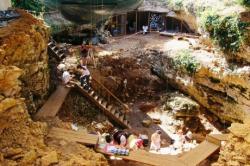 Les Pradelles - Le site des Pradelles vit ses dernières semaines de fouilles et de partenariat avec l'université américaine de Princeton. Ils sont 17, Américains et Canadiens. Ils ont entre 18 et 21 ans, et arrivent de la célèbre Université de Princeton, aux États-Unis. Ils participent aux fouilles archéologiques du site des Pradelles, à Marillac-le-Franc. Les étudiants de Princeton terminent aujourd'hui leur programme. Et concluent ainsi dix ans de collaboration autour du site des Pradelles. De ces dix années de fouilles ressortent trois découvertes : « Des dizaines de milliers d'ossements, des outils de l'Homme de Néandertal et une petite centaine de restes humains. » Si les analyses post-fouilles apporteront des réponses supplémentaires, Bruno Maureille et son équipe sont en mesure d'associer le site des Pradelles à une boucherie d'époque. Il y a quelque 70 000 ans, au cœur d'un climat sec et froid (semblable à celui de l'Islande actuelle), les Hommes de Néandertal profitaient de la physionomie du lieu pour découper leur gibier. Ils repartaient avec les bons morceaux et laissaient les restes derrières eux.
Les Pradelles - Le site des Pradelles vit ses dernières semaines de fouilles et de partenariat avec l'université américaine de Princeton. Ils sont 17, Américains et Canadiens. Ils ont entre 18 et 21 ans, et arrivent de la célèbre Université de Princeton, aux États-Unis. Ils participent aux fouilles archéologiques du site des Pradelles, à Marillac-le-Franc. Les étudiants de Princeton terminent aujourd'hui leur programme. Et concluent ainsi dix ans de collaboration autour du site des Pradelles. De ces dix années de fouilles ressortent trois découvertes : « Des dizaines de milliers d'ossements, des outils de l'Homme de Néandertal et une petite centaine de restes humains. » Si les analyses post-fouilles apporteront des réponses supplémentaires, Bruno Maureille et son équipe sont en mesure d'associer le site des Pradelles à une boucherie d'époque. Il y a quelque 70 000 ans, au cœur d'un climat sec et froid (semblable à celui de l'Islande actuelle), les Hommes de Néandertal profitaient de la physionomie du lieu pour découper leur gibier. Ils repartaient avec les bons morceaux et laissaient les restes derrières eux.
http://www.sudouest.fr/2012/07/20/arret-des-fouilles-sur-le-site-des-pradelles-774966-1200.php
USA – 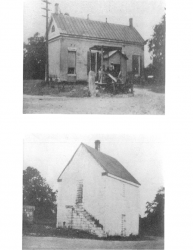 Stafford - A historical dig has uncovered Stafford’s original courthouse built in 1783. What appears to be the foundation of the old courthouse, which was torn down in 1910, has been unearthed at the steps of where today’s courthouse stands. Traces of mortar, brick fragments, creamware and pearlware – what George Washington and Civil War soldiers ate of off, respectively – have also been unearthed at the site, feet from where thousands of commuters travel at the intersection of U.S. 1 and Va. 630 (Courthouse Road). The five-week dig is about to wrap up, and comes prior to the start of a larger effort to transform Stafford’s courthouse area into a more pedestrian-friendly downtown. Stafford’s current courthouse was built in 1922, and the well that sits at the courthouse steps was a part of the original courthouse. Archeologists used photos of the old courthouse taken in the early 1900′s, noted positioning of the well, and used it as a guide to determine where the old courthouse stood. It’s believed the old courthouse was about 32-feet long. By 1900, the courthouse was in disarray after it had been used during the Civil War to quarter federal troops, and the well used for their horses to drink from.
Stafford - A historical dig has uncovered Stafford’s original courthouse built in 1783. What appears to be the foundation of the old courthouse, which was torn down in 1910, has been unearthed at the steps of where today’s courthouse stands. Traces of mortar, brick fragments, creamware and pearlware – what George Washington and Civil War soldiers ate of off, respectively – have also been unearthed at the site, feet from where thousands of commuters travel at the intersection of U.S. 1 and Va. 630 (Courthouse Road). The five-week dig is about to wrap up, and comes prior to the start of a larger effort to transform Stafford’s courthouse area into a more pedestrian-friendly downtown. Stafford’s current courthouse was built in 1922, and the well that sits at the courthouse steps was a part of the original courthouse. Archeologists used photos of the old courthouse taken in the early 1900′s, noted positioning of the well, and used it as a guide to determine where the old courthouse stood. It’s believed the old courthouse was about 32-feet long. By 1900, the courthouse was in disarray after it had been used during the Civil War to quarter federal troops, and the well used for their horses to drink from.
http://potomaclocal.com/2012/07/13/1783-courthouse-unearthed-in-stafford/